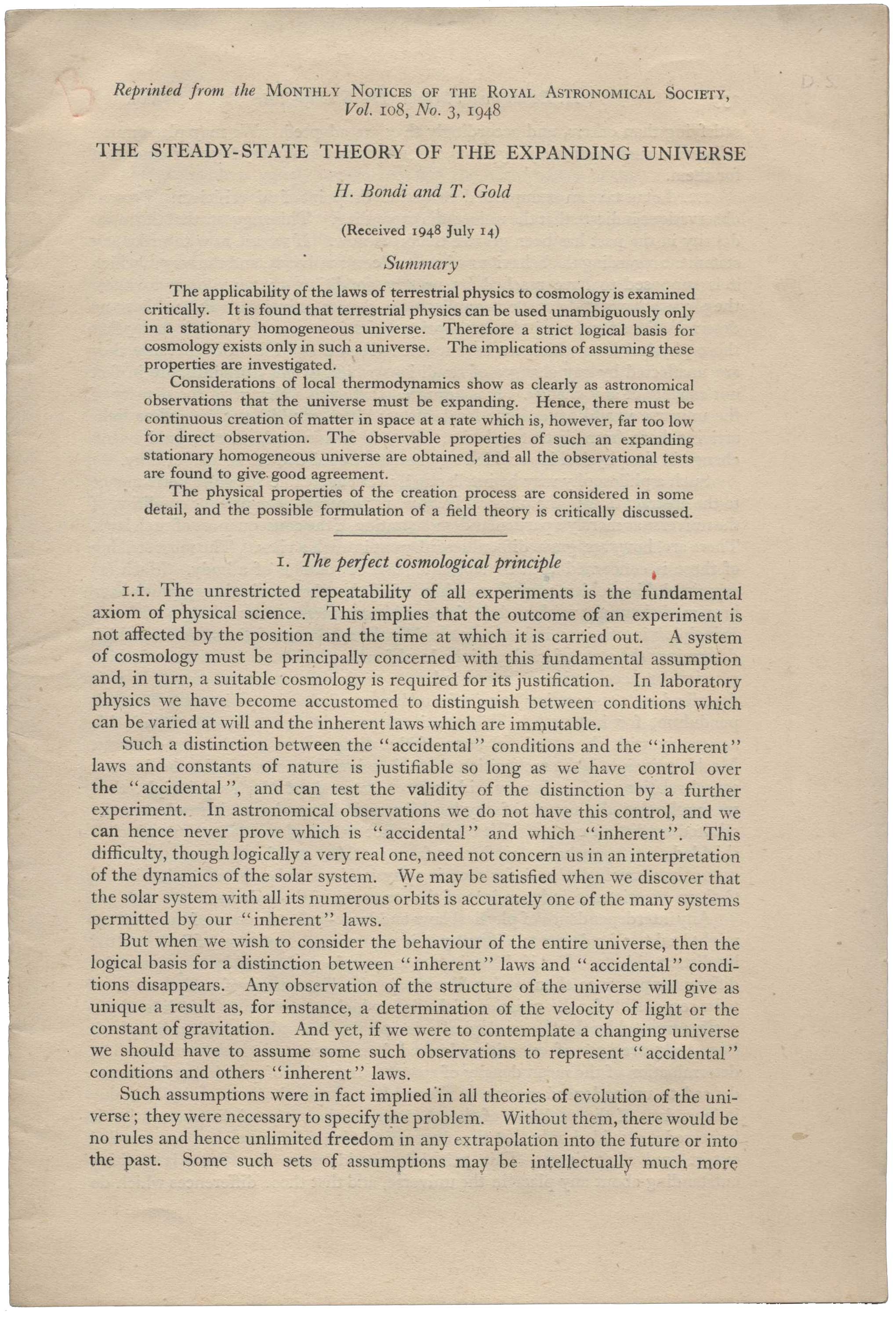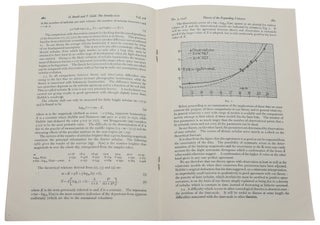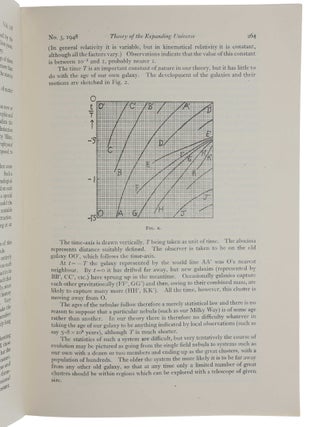The Steady-State Theory of the Expanding Universe.
London: Monthly Notices of the Royal Astronomical Society, 1948.
First edition, the extremely rare offprint, of the first published paper to propound the ‘steady-state’ model of the universe, according to which the universe is expanding but unchanging, with no beginning or end, and in which matter is continually being created throughout space so that its average density remains constant. Bondi and Gold’s Cambridge colleague Fred Hoyle published his own formulation of steady-state theory four months later in the same journal (‘A New Model for the Expanding Universe,’ MNRAS, Vol. 108, No. 5, pp. 372–382). Bondi, Gold and Hoyle were led to steady state theory because of well-known problems associated with the then current evolving models of the expanding universe: such models predicted a cosmic age that was problematic (less than the known age of some stars), and they disliked Lemaȋtre’s idea of a universe with an explosive beginning. Although the steady-state theory was eventually disproved by the discovery of the cosmic microwave background in the 1960s, “Steady state was of enormous importance in the history of astronomy, because it turned cosmology into a serious, observational part of science, by making predictions different from those of an evolutionary universe, for which Hoyle coined the name big bang. The predictions included numbers, sizes, colors, and brightnesses of galaxies at large distances compared to those near us” (DSB, under Gold). In 2014 an unpublished manuscript was discovered, probably dating from early 1931, in which Einstein himself considered the possibility of a universe that expands but remains essentially unchanged, his ‘cosmological constant’ being responsible for the continuous creation of matter from empty space (O’Raifeartaigh et al). We have located only one other copy of this offprint, at the Royal Society in London (no copy on OCLC). No copies in auction records.
“To the extent that there existed a standard cosmology in the late 1940s, it was the evolutionary universe based on Einstein’s field equations of 1917, either in the big bang version or the ever-expanding but no-bang Lemaître-Eddington version. In their discussions of 1946 and 1947, Hoyle, Gold, and Bondi agreed that an evolutionary universe governed by general relativity was unsatisfactory in whatever version. They concluded that an unchanging yet expanding universe was preferable, and for this reason they postulated continual creation of matter to occur throughout space at such a rate that it compensated for the expansion and left the average density of matter constant (the idea came from Gold). In early 1948, Gold and Bondi and, independently, Hoyle worked out their two formulations of the steady state universe.
The theory presented in the 1948 Bondi-Gold paper was deductively founded on what they called the perfect cosmological principle, the postulate that the universe is uniform not only spatially but temporally as well: it has always looked the same. This principle, they claimed, was a fundamental axiom from which physical results should be deduced; if theoretical extrapolations from experiments conflicted with the principle, such as did the law of energy conservation, they had to be rejected. Bondi and Gold consequently denied that the universe could be described by the energy-conserving theory of general relativity. Moreover, they objected that relativistic cosmology was “utterly unsatisfactory” because it covered so many models and was based on so many free parameters that as a whole it could not be falsified observationally. In spite of the qualitative and philosophical flavor of their paper, Bondi and Gold could prove that their theory led to a number of definite predictions, including a specific rate of matter creation of about 10-43 g/s/cm3. It also followed from their theory that the metric of the steady state universe had to be of the De Sitter type, a flat space expanding exponentially” (DSB, under Bondi).
“There is a charming story, not taken seriously by all historians, about how steady state theory began. The idea came in 1947, Hoyle claimed, when he and his fellow scientists Hermann Bondi and Tommy Gold went to a movie. The three knew each other from shared research on radar during World War II. Hoyle was versatile, undisciplined and intuitive; Bondi had a sharp and orderly mathematical mind; Gold's daring physical imagination opened new perspectives. The movie was a ghost story that ended the same way it started. This got the three scientists thinking about a universe that was unchanging yet dynamic. According to Hoyle, "One tends to think of unchanging situations as being necessarily static. What the ghost-story film did sharply for all three of us was to remove this wrong notion. One can have unchanging situations that are dynamic, as for instance a smoothly flowing river." But how could the universe always look the same if it was always expanding? It did not take them long to see a possible answer—matter was continuously being created. Thus new stars and galaxies could form to fill the space left behind as the old ones moved apart.
“To many philosophical minds, the steady-state universe proposed by Hoyle, Bondi and Gold had a major advantage over the big-bang expanding universe. In their universe the overall density was kept always the same by the continuous creation of matter. In the big-bang universe with its radically changing density, various physical laws might not apply the same way at all times. It would be impossible to extrapolate with confidence from the present back to the super-dense origin of the universe.
“Steady-state theory also had an observational advantage over big-bang theory in 1948. The rate of expansion then observed, when calculated backward to an initial big bang, gave an age for the universe of only a few billion years—well below the known age of the solar system! That was certainly an embarrassment for the big bang theory.
For some time cosmologists had measured ideas against a "cosmological principle," which asserted that the large-scale properties of the universe are independent of the location of the observer. In other words, any theory that put we humans at some special place (like the center of the universe) could be rejected out of hand. Bondi and Gold insisted that the universe is not only homogenous in space but also in time—it looks the same at any place and at any time. They grandly called this the "perfect cosmological principle," and insisted that theory should be deduced from the axiom that we are not at any special place in either space or time.
“Hoyle was less insistent that the perfect cosmological principle was a fundamental axiom. He preferred to have theory follow from a modification he proposed to Einstein's relativistic universe, adding the creation of matter. The two different steady-state theories had enough in common, however, to be considered one for most purposes.
“Much of the later development of steady-state theory came in response to criticism. In Great Britain, especially, scientists gave considerable attention to elaborating the theory. Their arguments were largely of a philosophical nature, with little appeal to observation.
“The cosmological debate acquired religious and political aspects. Pope Pious XII announced in 1952 that big-bang cosmology affirmed the notion of a transcendental creator and was in harmony with Christian dogma. Steady-state theory, denying any beginning or end to time, was in some minds loosely associated with atheism. Gamow even suggested steady-state theory was attached to the Communist Party line, although in fact Soviet astronomers rejected both steady-state and big-bang cosmologies as "idealistic" and unsound. Hoyle himself associated steady state theory with personal freedom and anti-communism.
“Astronomers in the United States found the steady-state theory attractive, but they took a pragmatic approach. The rival claims of big-bang and steady-state theory must be settled by observational tests. One test involved the ages of galaxies. In a steady state, with continuous creation of matter, there would be a mixture of young and old galaxies throughout the universe. In a big bang, with only an initial creation, galaxies would age with time. And astronomers could look back in time by looking at more distant galaxies, for observing a galaxy a billion light-years away meant seeing it in light that had left it a billion years ago. Observations reported in 1948 purported to find that more distant galaxies were indeed older. Score one for the big bang. Bondi and Gold reviewed the data carefully, and in 1954 they showed that the reported effect was spurious. Score one for steady state. The age test might be able to distinguish between the rival theories in principle, but in practice it could not.
“Another possible test involved the rate of expansion of the universe. In a big bang, the expansion rate would slow; in a steady state universe it would remain constant. Data from the Mount Wilson Observatory seemed to favor the big bang, but not certainly enough to constitute a crucial test.
“Meanwhile there was a solution to the embarrassing calculation that put the age of a big-bang universe less than the age of the solar system. Walter Baade showed that estimates of the distances to galaxies had mixed together two different types of stars. As a result, the size of the universe had been underestimated by about a factor of two. If galaxies were twice as distant as previously thought, then calculation with the observed rate of expansion gave an age of the universe twice as great as previously calculated — safely greater than the age of the solar system.
“The most serious challenge to steady-state theory came from the new science of radio astronomy. Fundamental knowledge in the techniques of detecting faint radio astronomy signals advanced greatly during World War II, especially with research on radar and especially in England. After the war, research programs at Cambridge, at Manchester, and at Sydney, Australia, built radio telescopes to detect signals from outer space. They dominated radio astronomy for the next decade.
“The program at Cambridge was led by Martin Ryle, who in 1974 would receive the Nobel Prize in physics for his overall contributions to radio astronomy. In 1951 Ryle believed that radio sources were located within our galaxy, and hence were of no cosmological interest. But over the next few years he became convinced that most of the radio sources he was detecting were extragalactic. His observations, then, could be used to test cosmological models. Ryle argued that his survey of almost 2,000 radio sources, completed in 1955, contradicted steady-state theory, because more distant/older sources seemed to be distributed differently from nearby ones. But he overstated the significance of his initial data. Only after more years of work would radio observations argue strongly against steady-state theory” (American Institute of Physics, http://history.aip.org/history/exhibits/cosmology/ideas/bigbang.htm).
Both Bondi (1919-2005) and Gold (1920-2004) were born into Jewish families in Vienna but left Austria shortly before the Anschluss. Bondi was admitted as a foreign student at Trinity College, Cambridge, where he arrived in the fall of 1937; Gold became an undergraduate student at Trinity in the following year. In 1940 the British government, concerned about possible fifth columnists, interned many Austrian and German émigrés as enemy aliens. Thus it was that Bondi and Gold, who did not previously know each other, met as internees in a camp in Quebec, Canada, where they soon became close friends. The slightly more senior camp resident Max Perutz organized an informal “school,” at which the young students could teach each other. Bondi’s extraordinary mathematical skills and Gold’s outstanding physical insights soon became obvious and complementary. Bondi and Gold did not return to England until 1942.
Hoyle (1915-2001) entered Emmanuel College, Cambridge in 1933 and went on to do graduate work in theoretical physics under Rudolf Peierls and Paul Dirac. In 1939 he secured a fellowship at St. John’s College, Cambridge. In 1940, the Admiralty (the British government department responsible for the Royal Navy) recruited Hoyle for theoretical research on radar. As director of the theory division at the radar establishment, Hoyle recruited Bondi in June 1942 and, on Bondi’s advice, in October 1942 Hoyle brought in Thomas Gold. Bondi, Gold, and Hoyle shared a small rented house close to their place of work, spending their evenings and weekends debating problems in astrophysics. All three returned to Cambridge in 1945, and from 1947 they started to work together on cosmology.
O’Raifeartaigh et al, ‘Einstein’s steady-state theory: an abandoned model of the cosmos,’ European Physical Journal 39, 353-367. For a very detailed account of the Bondi & Gold and Hoyle papers, see Kragh, Cosmology and Controversy (1996), pp. 162-201. The Einstein manuscript on a steady-state universe is ‘Zum kosmologischen Problem,’ Albert Einstein Archive Online, Archive No. 2-112, http://alberteinstein.info/vufind1/Record/EAR000034354
Offprint from: Monthly Notices of the Royal Astronomical Society, Vol. 108, No. 3, 1948. 8vo, pp. 252–270. Stapled as issued in self-wrappers.
Item #4162
Price: $3,500.00




